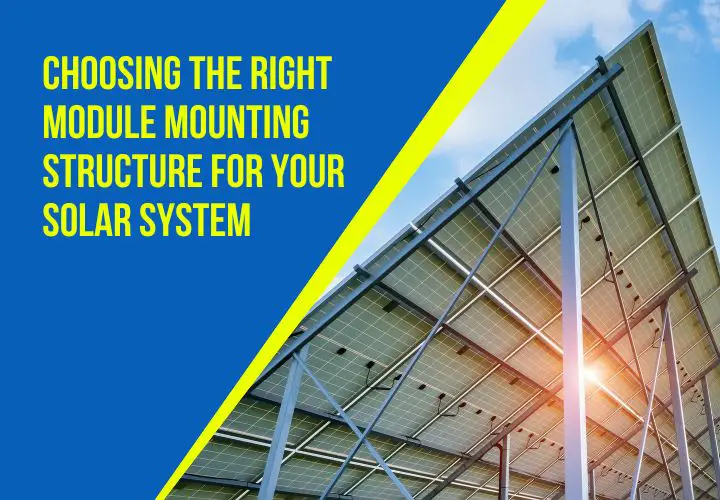Introduction
Investing in solar installation for a home in Tamil Nadu is one thing, but selecting the right module mounting structure is another equally important task. The mounting structure is the backbone of your solar system; it has to be able to hold the efficiency, reliability, and longevity of your solar panels in place. When there are many mountings, make sure that you understand their benefits as well as pick the best for your investment in solar energy.
Exploring Various Types of Solar Module Mounting Structure
There are multiple types of module mounting structures, depending on the type of installation and design requirements.
- Rooftop Mounting Structures – Aligned with urban houses with less ground space, these systems include fixed tilt, adjustable tilt, and ballasted rooftop mounted systems that best suit the purpose.
- Ground-mounted Structures – Best suited for homes with much space in the vicinity; such systems would allow the optimum orientation and tilt possible for maximum solar energy capture without any constraint.
- Pole Mounted Structures – These systems are usually used for smaller installations or off-grid systems since pole mounts usually lift the solar panels above any potential obstructions.
- Floating solar mounts – Innovative solar solutions that can be used both on land and in water. These can save space and reduce the evaporation of water.
- Carport Mounting Structures – The dual purpose of encompassing the shade of vehicles as well as supporting solar panels.
Key Factors to Consider When Choosing a Mounting System
Choosing a framework for module mounting involves the evaluation of several very important parameters:
Roof Type and Load Bearing Capacity: The roof material, angle, and strength need to be considered in case of rooftop installation.
Climate Resistance and Wind Load: High temperatures and cyclone threats are some of the dramatic changes that Tamil Nadu experiences, making it important to select a tough and wind-resistant system for mounting.
Orientation and Tilt Angle: Panel alignment must be proper to absorb the maximum sunlight and produce energy accordingly.
Space Availability: Rooftop and ground-mount systems require different planning spaces.
Future Expandability: It is advisable to choose a structure that allows one to expand its capacity in the future if needed.
How KCP Solar’s Mounting Solutions Enhance System Efficiency
Our efficient module mounting structure does a lot in optimising solar output. Proper angling and elevation minimise shading issues and promote airflow, which helps cool down panels and maintain performance. Our fixed-tilt structures give stability, while adjustable mounts provide seasonal angle changes for maximised yields. Thus, our engineers at KCP Solar offer you the best module mounting structure, keeping in mind the technological advancements and developments.
Balancing Cost and Quality in Solar Module Mounting Structures
While it is necessary to have an economic angle in solar mounting structures, at the same time, when quality is compromised, there could be recurring maintenance and even structural failure. Some cheap structures are built with inferior-quality materials, which tend to corrode after some time. Therefore, the use of an inexpensive module mounting structure becomes detrimental to the overall life of the solar installation. Buying high-quality module mounting frameworks increases reliability, cuts maintenance costs, and increases the return in the long run.
Durability of Materials and Design Considerations for Mounting Systems
The life of any module mounting structure ultimately depends on the materials used.
Aluminium mounts – They are lightweight, rust-free, and perfect for rooftops.
Galvanised Steel Mounts – They are very strong, economical, and ideal for use in high-wind areas.
Stainless Steel Mounts – Highly durable and corrosion resistant, but quite expensive.
Best Practices for Installing Solar Mounting Structures
The following are best practices to ensure a smooth and efficient solar installation for a home in Tamil Nadu:
- Conduct a structural assessment to determine load capacity.
- Use corrosion-resistant fasteners to secure the mounting system.
- Ensure proper spacing between panels to prevent shading.
- Local regulations and manufacturer Installation guidelines should be followed.
- Hire certified professionals to guarantee a safe and compliant setup.
Conclusion: Making The Right Choice
Choosing the right module mounting structure is fundamental to successful solar installation for homes in Tamil Nadu. The best system enhances efficiency, withstands local weather conditions, and ensures that the solar panels will serve for a longer lifespan. With all these considerations of durability, cost, and installation requirements in mind, homeowners undoubtedly make the right decisions to maximise their investment in solar. Whether it is a rooftop, ground-mount, or specialised structure, a high-quality mounting solution from KCP Solar always acts as a long-term benefit in optimal solar performance.


